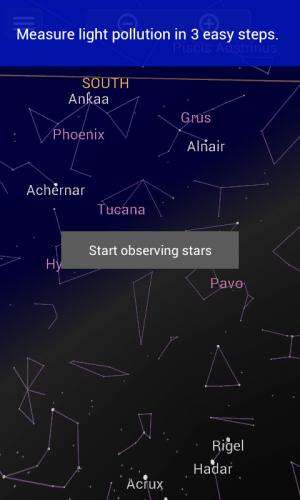Twinkle, twinkle little star: New app measures sky brightness

Researchers from the German "Loss of the Night" project have developed an app for Android smart phones, which counts the number of visible stars in the sky. The data from the app will be used by scientists to understand light pollution on a world wide scale.
"In natural areas you can see several thousand stars with the naked eye" says Dr. Christopher Kyba, physicist at the Freie Universität. "In Berlin, we can still see several hundred, but the situation in most large cities and world capitals is far worse."
The smartphone app will evaluate sky brightness, also known as skyglow, on a worldwide scale. It will be an extension to the "GLOBE at Night" citizen science project, which has been running since 2006. This data can be used to map the distribution and changes in sky brightness, and will eventually allow scientists to investigate correlations with health, biodiversity, energy waste and other factors.
The app works by interactively asking users to say whether individual stars are visible. By determining what the faintest visible star is, the researchers learn how many stars are visible at that location, and by extension how bright the sky is.
"Life evolved periodic changes of bright days and dark nights" says Dr. Annette Krop-Benesch of the Leibniz-Institute of Freshwater Ecology and Inland Fisheries (IGB). "The introduction of artificial light into the atmosphere is changing ecosystems worldwide, and might even have an impact on our health. Unfortunately, we have very little information about light levels in different habitats at night."
"With this app, people from around the world can collect data on skyglow without needing expensive equipment." says Fabian Kohler from The German Ministry of Education and Research (BMBF). The app allows users to compare the sky brightness at their home to other locations, and some of the testers found that without intending too they learned the names of several stars and constellations.
The app was developed in partnership with the firm Cosalux (Offenbach am Main), and is based on the widely used Google Sky Map application. The development of the app was sponsored by the German Federal Ministry of Research and Education, as part of Science Year 2012: "Project Earth: Our Future".
The researchers noted that satellites that observe Earth at night measure the light that is radiating into the sky, not the brightness that is experienced by people and other organisms on the ground. They say that models can use satellite data to provide estimates of how bright the sky is, but these models need to be tested, and that the app data will be able to do this. Another drawback of the current night observing satellites, according to the researchers, is that they aren't sensitive to certain wavelengths of light. This means that areas lit by white LED lights appear darker then they really are.
The project was funded by the German Ministry of Education and Research.
More information: play.google.com/store/apps/det … .cosalux.welovestars
Provided by Forschungsverbund Berlin e.V. (FVB)



















